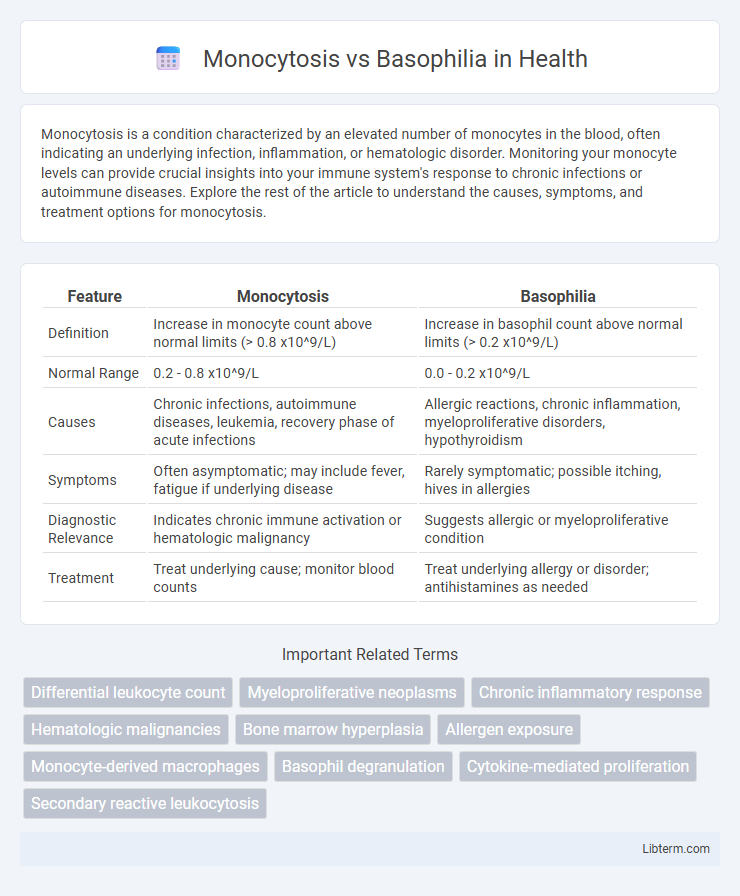Monocytosis is a condition characterized by an elevated number of monocytes in the blood, often indicating an underlying infection, inflammation, or hematologic disorder. Monitoring your monocyte levels can provide crucial insights into your immune system's response to chronic infections or autoimmune diseases. Explore the rest of the article to understand the causes, symptoms, and treatment options for monocytosis.
Table of Comparison
| Feature | Monocytosis | Basophilia |
|---|---|---|
| Definition | Increase in monocyte count above normal limits (> 0.8 x10^9/L) | Increase in basophil count above normal limits (> 0.2 x10^9/L) |
| Normal Range | 0.2 - 0.8 x10^9/L | 0.0 - 0.2 x10^9/L |
| Causes | Chronic infections, autoimmune diseases, leukemia, recovery phase of acute infections | Allergic reactions, chronic inflammation, myeloproliferative disorders, hypothyroidism |
| Symptoms | Often asymptomatic; may include fever, fatigue if underlying disease | Rarely symptomatic; possible itching, hives in allergies |
| Diagnostic Relevance | Indicates chronic immune activation or hematologic malignancy | Suggests allergic or myeloproliferative condition |
| Treatment | Treat underlying cause; monitor blood counts | Treat underlying allergy or disorder; antihistamines as needed |
Understanding Monocytosis: Definition and Causes
Monocytosis refers to an elevated monocyte count in the blood, often signaling chronic inflammation, infections such as tuberculosis or viral illnesses, and certain hematologic disorders. Basophilia, characterized by an increased basophil count, typically indicates allergic reactions, chronic myelogenous leukemia, or inflammatory diseases. Distinguishing monocytosis from basophilia is crucial for accurate diagnosis and targeted treatment, as their underlying causes and clinical implications differ significantly.
Basophilia Explained: Meaning and Underlying Conditions
Basophilia refers to an elevated number of basophils in the blood, often indicating chronic inflammation, allergic reactions, or myeloproliferative disorders such as chronic myeloid leukemia. Basophils, a type of white blood cell, play a crucial role in immune responses by releasing histamine and other chemicals during allergic reactions. Understanding the underlying conditions behind basophilia is vital for accurate diagnosis and targeted treatment, distinguishing it from monocytosis, which involves elevated monocytes commonly linked to infections and autoimmune diseases.
Hematological Differences: Monocytes vs Basophils
Monocytosis is characterized by an increased number of monocytes, which are large phagocytic white blood cells involved in pathogen destruction and immune regulation. Basophilia involves elevated basophil counts, a type of granulocyte that releases histamine and plays a crucial role in allergic reactions and inflammation. Hematologically, monocytes are agranulocytes with a kidney-shaped nucleus and abundant cytoplasm, while basophils are granulocytes with bi-lobed nuclei and cytoplasmic granules containing histamine and heparin.
Clinical Presentation: How Monocytosis and Basophilia Manifest
Monocytosis typically manifests with persistent infections, chronic inflammation, or hematologic disorders, presenting symptoms like fatigue, fever, and weight loss due to increased monocyte counts in the blood. Basophilia often accompanies allergic reactions, myeloproliferative diseases, or hypothyroidism, with clinical signs including pruritus, urticaria, and an enlarged spleen resulting from elevated basophil levels. Both conditions reflect underlying systemic issues, requiring differential diagnosis through blood tests and clinical correlation for accurate identification.
Diagnostic Approaches for Monocytosis and Basophilia
Diagnostic approaches for monocytosis involve complete blood counts (CBC) with differential to quantify elevated monocyte levels, typically exceeding 1,000 cells/uL, alongside peripheral blood smear analysis to identify reactive or clonal monocyte populations. Bone marrow biopsy may be warranted to distinguish between reactive monocytosis caused by infections or inflammatory conditions and hematologic malignancies such as chronic myelomonocytic leukemia. In basophilia, diagnosis relies on CBC showing basophil counts above 200 cells/uL, with molecular testing for BCR-ABL1 fusion gene and JAK2 V617F mutation to identify underlying myeloproliferative neoplasms like chronic myeloid leukemia and polycythemia vera.
Common Diseases Associated with Monocytosis
Monocytosis is frequently associated with chronic infections such as tuberculosis, bacterial endocarditis, and viral infections like mononucleosis. Hematologic disorders including chronic myelomonocytic leukemia and other myelodysplastic syndromes also commonly present with monocytosis. In contrast, basophilia is primarily linked to myeloproliferative disorders such as chronic myeloid leukemia and certain allergic or inflammatory conditions.
Conditions Linked to Basophilia
Basophilia is commonly linked to conditions such as chronic myelogenous leukemia, myeloproliferative disorders, and allergic reactions, distinguishing it from monocytosis which is often associated with infections and inflammatory diseases. Elevated basophil counts may also indicate hypothyroidism, ulcerative colitis, and certain viral infections. Monitoring basophil levels helps clinicians diagnose and manage these specific hematologic and immune-related conditions.
Laboratory Evaluation: Key Blood Test Markers
Monocytosis is characterized by an elevated absolute monocyte count, typically exceeding 0.8 x 10^9/L, often identified through a complete blood count (CBC) with differential. Basophilia involves an increased basophil count, usually above 0.1 x 10^9/L, detected via similar hematological assays. Both conditions require analysis of white blood cell differentials, but monocytosis is frequently associated with chronic infections and inflammatory states, whereas basophilia is more commonly linked to myeloproliferative disorders and allergic reactions.
Treatment Strategies for Each Blood Disorder
Monocytosis treatment strategies primarily involve addressing underlying infections, autoimmune diseases, or hematological malignancies, often utilizing corticosteroids or immunosuppressive agents to reduce elevated monocyte levels. Basophilia management focuses on treating the root causes such as myeloproliferative disorders or allergic reactions, with therapies including antihistamines, cytoreductive drugs like hydroxyurea, or targeted therapies such as tyrosine kinase inhibitors. Both conditions require close monitoring of blood counts and tailored therapeutic approaches based on the identified etiology.
Prognosis and Clinical Significance of Monocytosis vs Basophilia
Monocytosis often indicates chronic infections, autoimmune disorders, or hematologic malignancies, with prognosis depending on the underlying cause and response to treatment. Basophilia is commonly associated with allergic reactions, chronic inflammation, and myeloproliferative disorders, sometimes signaling disease progression or more severe pathology. Clinically, monocytosis suggests ongoing immune activation or marrow involvement, whereas basophilia may denote allergic or neoplastic conditions requiring targeted diagnostic evaluation.
Monocytosis Infographic

 libterm.com
libterm.com